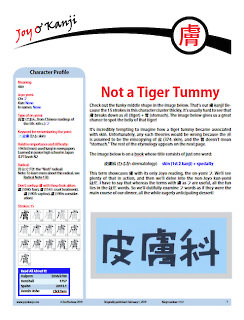ŔćÜ
skin
Kanji 1757
skin
Thank you for visiting this Character Home Page. Below you'll find a synopsis of the essay. If you wish to read the full text, the PDF of the essay is available for purchase to the right.
Synopsis
“A chameleon can change its skin color and blend in with surrounding trees.” “Ayako’s skin is sensitive to chemicals.” “My son’s skin breaks out easily.” “This cloth has a nice texture.” Discover how to say all these things while discovering the etymology of ŔćÜ, which seems to contain “tiger” and "stomach.” Find out about an idiom involving “unwounded skin,” and see how people refer to “autumn chill” even in spring.
Revision history:
Aug. 23, 2024:
- p. 2: There are actually 4 Joyo kanji that mean "skin," so I added this comment: "The ÚŁę kanji, which primarily means 'leather,' symbolizes animal skin.
- p. 7: Changed the def. of Š×»ŃéîŔéî to "dry, withered skin."
- p. 10: Added this comment: "Whereas Ńü»Ńüá is common as a reading of Ŕéî/ŔćÜ, the archaic Ńü»ŃüáŃüł is now unused."
- p. 10–11: Revised comments about how Ŕéîň»ĺŃüä/ŔćÜň»ĺŃüä relates to autumn.
- p. 12 sidebar: Added šÖŻŔéî as the primary rendering of ŃüŚŃéëŃü»Ńüá.
- p. 13: Changed the breakdown of ňť░Ŕéî/ňť░ŔćÜ to "natural + skin."
- p. 13: Changed the def. of ŔéîŔžŽŃéŐ/ŔćÜŔžŽŃéŐ to "feeling on the skin; texture" and slightly modified the subsequent paragraph.
Feb. 17, 2022:
- pp. 1 and 2, Etymology Box: Updated the Henshall etymology and then revised the etymological discussion on p. 1.
- p. 15: Added a link to the Kanshudo games.
Feb. 1, 2019: Originally published.



Comments